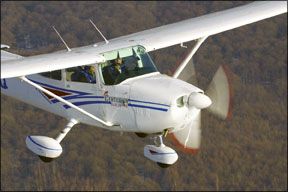Now that Cessna has announced that it too will offer the Thielert diesel in the ever-popular Skyhawk, were moved to wonder if Diamond was too early and Cessnas late to the game. We may never know, but Cessna clearly has one advantage: The diesel Skyhawk will have the new-and-improved Centurion 2.0, not the first-gen 1.7. If the 2.0 corrects the 1.7s nagging maintenance issues, the Skyhawk may be positioned to (again) become an airplane for the global market.

Although Cessna officially announced the Cessna 172 Skyhawk TD at AOPA Expo in October, the proposed airplane is the result of many months of development. As of press time, the test article had about 35 flight hours, according to program director Pat Winter, but Cessnas serious interest in Jet A piston power began at least three years ago, when it began a few hundred hours of test flights in a Centurion 1.7 Skyhawk. Historically, Cessna has always had a taste for trying exotic engines, even if its not inclined to try to sell them. (In the McCauley Division building at Cessnas old Pawnee site, there’s a Chevy V-6 engine in a Crusader and a version of the Dyna-Cam engine, an alternate design that never flowered.)
Two things convinced Cessna to move on diesels now: The first was Thielerts 155-HP Centurion 2.0 and the second was the rising realization that avgas is getting both expensive and impossible to find in some parts of the world, while Jet A or diesel is widely available.
Thielert has certified the 2.0 to use both fuels in Europe, however, their U.S. engines are limited to burning Jet A. The infrastructure for this fuel is already in place, something that cant be said for alternatives to leaded avgas. Cessna had been disappointed in the performance of the 1.7 liter diesel Skyhawk, but the addition of 20 horsepower in a package virtually the same size prompted them to reconsider.
The difference between the 1.7 and 2.0 liter engines is basically a new cylinder block boosting displacement from 103.07 cubic inches to 121.5 cubic inches. Bore was increased from 3.15 to 3.26 inches and stroke from 3.307 to 3.62 inches. There are also changes in the gearbox and clutch and cylinder head designs, all of which are supposed to address maintenance complaints we heard from many Diamond and Cessna conversion owners.
Speaking of which, did Cessna know about these? Not in precise detail, Winter told us, although Cessna was aware of some engine failures from its own research into the Centurion 1.7. Winter told us that Cessnas experiences flying the 1.7 rang no maintenance alarm bells.
The Thielert package will include the engine, FADEC, turbocharger, starter, alternator and exhaust system, all integrated into the aircrafts Garmin G1000 package. Cessna will forego the standard Thielert throttle quadrant-type lever for a push pull knob, both for its ease of operation and its familiarity in a Cessna cockpit. Cost wise, the Centurion will command a $15,000 price premium and its expected to be available in the third quarter of 2008. To accelerate the airplanes trek to market, Cessna will install the diesel under an STC rather than developing its own new type certificate.
No surprise that the diesel Skyhawks performance suffers in a couple of areas-takeoff ground run and initial climb. But climb rate above 3000 feet is better than the gasoline Hawk and although the diesel version carries 12 fewer gallons, its lower fuel burn gives it a slightly better maximum range, by our calculations. (In a recent test flight, at 62 percent power, we observed a mere 6.4 GPH.) But the diesel is heavier by 66 pounds and according to Cessnas Web site, that yields 93 pounds less in useful load for the Skyhawk TD compared to the SP.
One thing Diamond owners have complained about is the 1.7s short TBR-time between replacement-of 1000 to 1200 hours. For the Skyhawk TD, Cessna and Thielert are planning on a 2400-hour TBR. Given the less than stellar service and longevity of prior engines, Cessna had Thielert implement a life extension program, with accelerated testing on their Lichtenstein, Germany, facilitys four engine dynos. Chris Batcheller, a Propulsion Engineer for Cessna, told us that Thielert addressed any maintenance issues and “with our scheduled maintenance program, we are confident we can achieve the 2400-hour goal.”
The largest challenge for Cessna may be similar to that confronted by Diamond: parts, support and supply chain. Winter says hes aware of the issues and insists Cessna will be ready with trained dealers, support and parts supplies. “It still says Cessna on the side and we have to live up to that,” he told us.
As the 800-pound gorilla of GA manufacturing, Cessna is in a position to hold Thielerts feet to the fire on support. Ironically, Diamond may benefit from that, if it continues with Thielert as an engine vendor. If Cessna gives Thielert no choice but to build the kind of North American support network Cessna owners have come to expect, any OEM flying Thielert diesels will likely enjoy better support.


